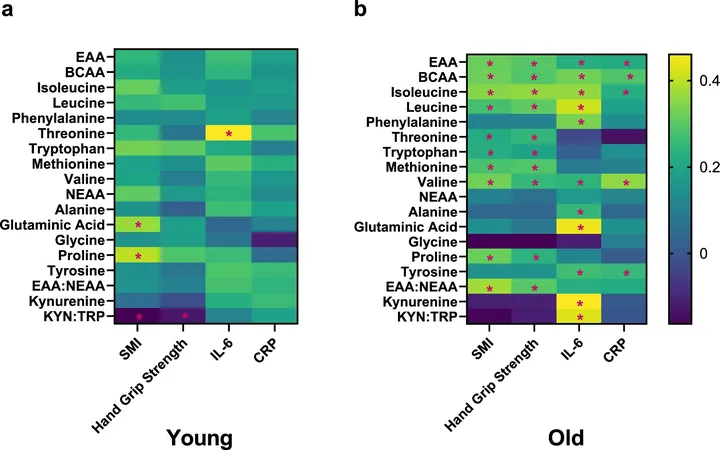
Are Your Amino Acids Sabotaging Your Muscle Health? Discover the Latest Research!
2025-03-25
Author: Mei
Introduction
As our society ages, the decline in muscle mass and strength has emerged as a pressing health challenge. Researchers at the German Institute of Human Nutrition Potsdam-Rehbruecke (DIfE), led by Prof. Kristina Norman, have revealed that amino acid profiles could act as promising biomarkers for assessing muscle health in older adults. This breakthrough could enable earlier identification of individuals at heightened risk for sarcopenia, potentially allowing for targeted interventions designed to improve their quality of life as they age.
Understanding Sarcopenia
Sarcopenia, characterized by progressive loss of skeletal muscle, affects both physical capability and overall health. This complex condition is influenced by numerous factors, including physical activity levels, age, gender, and metabolic health. Current research suggests that by utilizing amino acid profiling, we can better evaluate the health of skeletal muscles in older individuals.
The Role of Amino Acids
Amino acids, which constitute merely 2% of the total amino acids in the human body, are pivotal for maintaining skeletal muscle function. These free amino acids circulate in blood plasma and cells, affected by metabolic shifts, dietary choices, lifestyle factors, and genetic predispositions. They also play critical roles in inflammatory responses and insulin sensitivity, both of which are pertinent to age-related muscle deterioration.
Circulating Amino Acids: The Key to Keeping Muscles Strong
Skeletal muscle is the predominant source of circulating amino acids in the body, establishing a direct relationship between amino acid levels and muscle mass. Prof. Norman highlights a stark difference in amino acid profiles between older adults experiencing physical frailty or sarcopenia and healthier counterparts. “Older adults showed a distinct amino acid composition compared to younger individuals, indicating that muscle decline has a measurable impact on metabolic processes,” she stated.
Research Findings
In their latest study, Prof. Norman’s team analyzed data from 131 individuals—comprising 30 young adults (ages 18-35) and 101 older adults (ages 65-85). They assessed metrics such as weight, height, body mass index (BMI), hand grip strength, and body composition through bioelectrical impedance analysis.
Research results revealed that the older participants had a higher BMI coupled with lower skeletal muscle mass and diminished hand grip strength. While inflammatory markers remained relatively consistent, the older adults exhibited decreased levels of essential (EAA) and branched-chain amino acids (BCAA), which were linked to reduced muscle mass.
Unlocking the Future of Muscle Health: Biomarkers to Prevention Strategies
Research findings affirm previous studies indicating that circulating amino acids can serve as effective indicators of muscle health in older individuals. “Our analysis uncovers that amino acid profiles may serve as early biomarkers of muscle health deterioration,” remarked lead author Donna Li. Future research will delve into how these findings apply to individuals diagnosed with sarcopenia to further understand pathological changes in amino acid concentrations.
Prof. Norman emphasized the importance of advancing this research: “We require more studies to translate our discoveries into preventative and therapeutic strategies aimed at preserving muscle function in older age.” The ultimate goal is to devise personalized intervention strategies, focusing on nutrition and physical activity tailored to optimize amino acid metabolism, fostering enhanced muscle health in our aging population.
Conclusion
By harnessing the power of amino acids, we could significantly enhance the quality of life for countless elderly individuals. Stay tuned for more exciting updates from the world of nutritional science!



 Brasil (PT)
Brasil (PT)
 Canada (EN)
Canada (EN)
 Chile (ES)
Chile (ES)
 Česko (CS)
Česko (CS)
 대한민국 (KO)
대한민국 (KO)
 España (ES)
España (ES)
 France (FR)
France (FR)
 Hong Kong (EN)
Hong Kong (EN)
 Italia (IT)
Italia (IT)
 日本 (JA)
日本 (JA)
 Magyarország (HU)
Magyarország (HU)
 Norge (NO)
Norge (NO)
 Polska (PL)
Polska (PL)
 Schweiz (DE)
Schweiz (DE)
 Singapore (EN)
Singapore (EN)
 Sverige (SV)
Sverige (SV)
 Suomi (FI)
Suomi (FI)
 Türkiye (TR)
Türkiye (TR)
 الإمارات العربية المتحدة (AR)
الإمارات العربية المتحدة (AR)